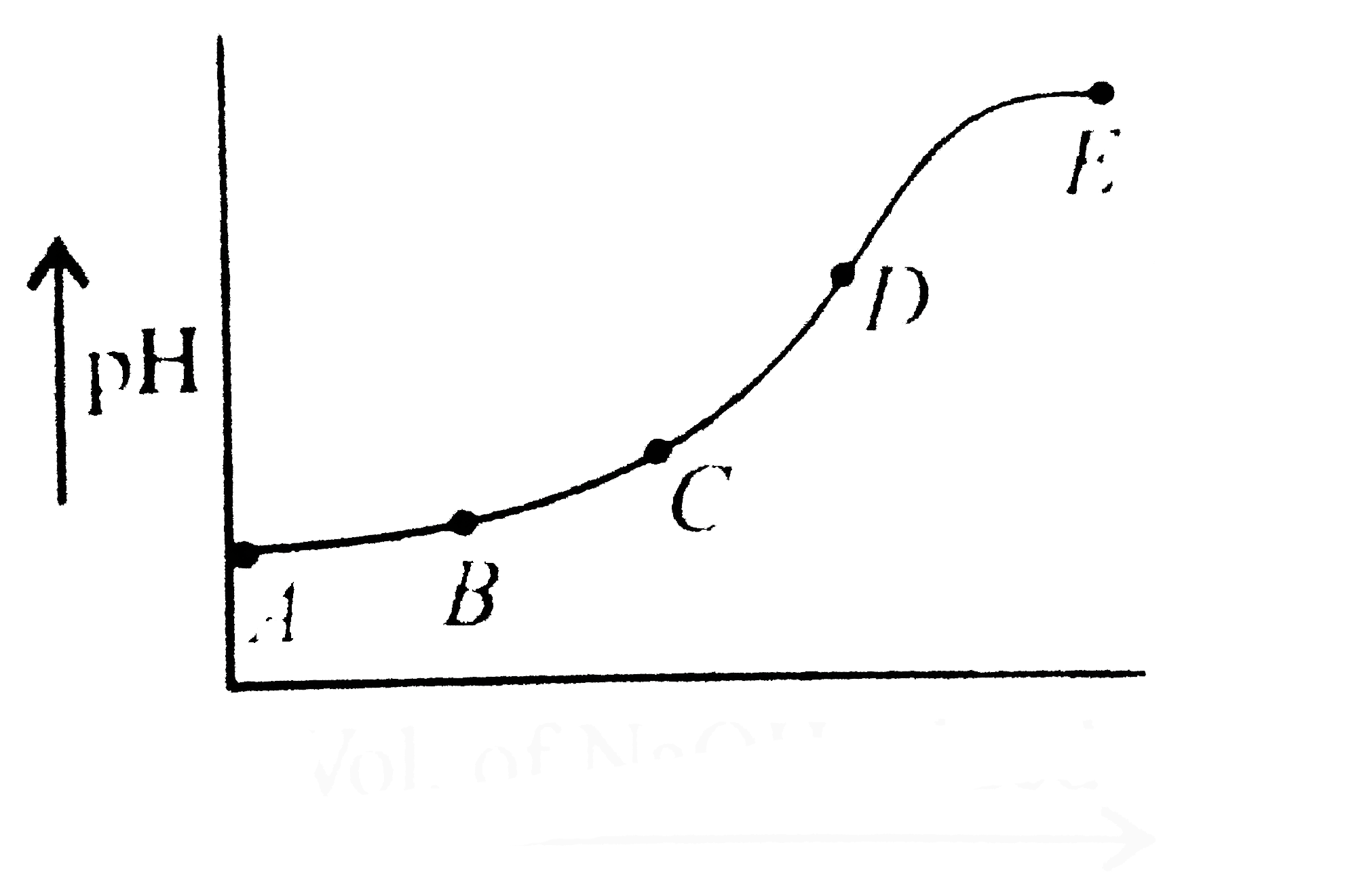Complete Solutions to Ex 8.4 of chapter IONIC EQUILIBRIUM of Class 11 book with complete answers and questions
| Class 11 | CHEMISTRY |
| Chapter | IONIC EQUILIBRIUM |
| CENGAGE CHEMISTRY | Ex 8.4 |
| Number Of Questions | 39 |
| Academic Year | 2023-24 |
a. At what `pH` does indicator change colour if the indicator is a weak acid with `K_(Ind) = 4.0 xx 10^(-4)`.
b. For which of the following neutralisation would the indicator be useful?
i. `HCl +NaOH`
ii. `CH_(3)COOH +NaOH`
iii. `HCl +NH_(3)`
c. Name the indicators which can be used for such titration.06:15View SolutionThe acid from of an acid base indicator is yellow in acid and red in basic from. What is the change in `pH` in order to change the indicator form `80%` yellow to `80%` red.
03:48View SolutionGiven that solubility product of `BaSO_(4)` is `1 xx 10^(-10)` will be precipiate from when
Equal volumes of `2 xx 10^(-3)M BaCl_(2)` solution and `2 xx 10^(-4)M Na_(2)SO_(4)` solution, are mixed?03:43View SolutionThe `K_(sp)` of `AgC1` at `25^(@)C` is `1.6 xx 10^(-9)`, find the solubility of salt in `gL^(-1)` in water.
02:52View SolutionIf solutbility of `Ca(IO_(3))_(2)` in water at `20^(@)C` is `3.9gL^(-1)`. Calculate the `K_(sp)`. Given `Mw Ca(IO_(3))_(2) = 390`.
02:13View SolutionFind the solubility of `Ca(IO_(3))_(2)` is `molL^(-1)` in a solution containing `0.1M CaC1` at `25^(@)C`. `K_(sp)` of `Ca(IO_(3))_(2) = 6.3 xx 10^(-7)`
02:25View SolutionThe solubility product `(K_(sp))` of `BaSO_(4)` is `1.5xx10^(-9)`. Calculate the solubility of barium sulphate in pure water and in 0.1 M `BaCl_(2)`.
03:30View SolutionA solution contains `1.4 xx 10^(-3)M AgNO_(3)`. What concentration of `KC1` will be required to initiate the precipitation of `AgC1 ? K_(sp) AgC1 = 2.8 xx 10^(-10)`
03:20View SolutionIf the solubility of `CaSO_(4)` in `H_(2)O` is `10^(-5)M`, Calculate the solubility in `0.005M` solution of `H_(2)SO_(4)`.
03:34View SolutionThe concentration of `Ag^(o+)` ions in a saturated solution of `Ag_(2)C_(2)O_(4)` is `2.2 xx 10^(-4)M`. Calculate the solubility product of `Ag_(2)C_(2)O_(4)`
02:28View Solution`500mL` of `2 xx 10^(-3)M A1C1_(3)` and `500mol` of `4 xx 10^(-2)M` solution of `NaOH` are mixed and solution is diluted to `10^(-2)L` with water at room temperature wil a precipiate exist? Given:
`K_(sp)`of `A1(OH)_(3) = 5 xx 10^(-33)`.05:01View SolutionYou are provided with `500mL` of hard water, containing `0.005 mol` of `CaC1_(2)` and two `H_(2)SO_(4)` samples of `0.001M` and `0.02M` concentration. Which one or both or none can be used for precipitating `Ca^(2+)` ions.
`K_(sp)` of `CaSO_(4) = 2.4 xx 10^(-4)`.04:38View SolutionA lead salts is dissolved in `HC1` which si `94%` ionised. It is found to have `0.1M Pb^(2+)` and `0.28M H^(o+)` ions. The solution is satured with `H_(2)S(g)`. Calculate the amount of `Pb^(2+)` ions that remains unprecipitated.
`K_(sp)` of `PbS = 4 xx 10^(-29)`,
`K_(sp)` of `H_(2)S = 1.1 xx 10^(-22)`03:44View SolutionA solution constains `Zn^(2+)` ions and `Cu^(2+)` ions each of `0.02M`. If the solution is made `1M` in `H^(o+)`, and `H_(2)S` is passed untill the solution is satured, should a precipitate be formed? Given: `K_(sp) ZnS = 10^(-22)`,
`K_(sp) Cus = 8 xx 10^(-37)`.
In satured solution, `K_(sp) (H_(2)S) = 10^(-22)`03:36View SolutionThe following `pH` range where the indicator shows change in colour are given
i. `4 - 9.7` ii. `7.46-10.0` iii. `6.5-4`
Which of the above `pH` range represent titration of
I. Strong acid/strong base `(S_(A)//S_(B))`,
II. Weak acid/strong base `(W_(A)//S_(B))`,
III. Weak base/strong acid `(W_(B)//S_(A))`03:12View SolutionThe following acid base titration graphs are given:
(I)
Which of the following graph represents titration of
i. `NH_(4)OH//HCl(W_(B)//S_(A))`
ii. `HNO_(3)//KOH(S_(A)//S_(B))`
iii. `C_(6)H_(5)COOH//KOH(W_(A)//S_(B))`04:21View SolutionWhat indicators will be suitable for the following acid-base titrations:
a. `HCOOH` against `NaOH`
b. `HBr` against `KOH`
c. `NH_(4)OH` with `HNO_(3)`06:21View SolutionA solution gives the following colours with different indicators:
a. Methy`1` orange `rArr` Yellow
b. Methy`1` red `rArr` Yellow
c. Bromothymol blue `rArr` Orange
What is the `pH` of the solution?02:57View SolutionIn the titration of `NH_(4)OH` versus `HCl`, the `pH` of the solution at equivalence point is about:
04:11View SolutionThe `pH` indicators are
03:58View SolutionIn which of the following acid-base titration, the pH is greater than 8 at the equivalence point ?
06:59View SolutionStrong acids are generally used as standard solution in acid-base titrations because:
02:56View SolutionThe best indicator for detection of end point in titration of a weak acid and a strong base is
02:01View SolutionThe precipitate of `CaF_(2) (K_(sp)=1.7xx10^(-10))` is obtained when equal volumes of the following are mixed
04:21View SolutionThe solubility of `A_(2)B_(3)` is "x mol dm"^(-3)`. Its `K_(sp)` is
01:31View SolutionThe `pH` of `Ca(OH)_(2)` is `10.6` at `25^(@)C. K_(sp)` of `Ca(OH)_(2)` is
02:30View SolutionSolubility of `AgI` in `0.05M BaI_(2)` solution is `10^(-15)M`. The solubility of `AgI` in water is
03:22View SolutionSolubility of a solute in water is dependent on temperature as given by
`S=Ae^(-DeltaH//RT)`, where `DeltaH`=heat of solution
`"Solute"+H_(2)O(l) hArr "Solution", DeltaH= +- x`
For given solution, variation of log S with temperature is shown graphically. Hence, solution is
 04:58View Solution
04:58View SolutionThe solubility of `CaF_(2)` in a solution of `0.1M Ca(NO_(3))_(2)` is
01:39View SolutionThe volume of water needed to dissolve `1mg` of `PbSO_(4) (K_(sp) = 1.44 xx 10^(-8), Mw of PbSO_(4) = 303g)` at `25^(@)C` is
03:42View SolutionThe volume of water needed to prepare a satured solution of `Ag^(o+)` having maximum `[Ag^(o+)]` ion by selecting one out of three slats form:
`AgC1(K_(sp) = 2.0 xx 10^(-10)), AgBr (K_(sp) = 5 xx 10^(-13))`, and `Ag_(2)CrO_(4)(K_(sp) = 2.4 xx 10^(-12))`. whcih compound should be used to have maximum `[Ag^(o+)]`?05:05View SolutionHow many grams of `KBr` can be added to `1L` of `0.12 M` solution of `AgNO_(3)` just to start the precipitation of `AgBr. (Mw "of" KBr = 120, K_(sp) of AgBr = 10^(-13))`
03:51View SolutionThe solubility of silver benzoate `(C_(6)H_(5)COOAg)` in `H_(2)O` and in a buffer solution of `pH = 2, 3`, and `4` are `S_(1), S_(2), S_(3)` and `S_(4)` respectively. The decreasing order of solubility is
03:09View SolutionThe solubility of `CH_(3)COOAg` in a buffer solution with `pH = 4`, whose `K_(sp) = 10^(-12)` and `K_(a) = (10^(-4))/(3)` is
02:07View Solutionthe ratio of solubility of `CH_(3)COOAg` in a buffer solution with `pH = 4` and in `H_(2)O` is
`(Sol Buffer = 2 xx 10^(-6))`02:11View SolutionWhat is the maximum molarity of `Co^(+2)` ions in `0.1M HC1` saturated with `0.1M H_(2)S. (K_(a) = 4 xx 10^(-21))`. Given: `K_(sp)` of `CoS = 2xx10^(-21)`.
03:12View SolutionThe following curve shows the change of `pH` during the course of titration of weak acid `HA` with a strong base. At which point in the titration curve is the concentration of acid equal to that of its conjugate base.
 02:14View Solution
02:14View SolutionIf the salts `M_(2)X,QY_(2)`, and `PZ_(3)` have the same solubilities `(lt(4)/(27))`, their `K_(sp)` values are related
04:01View SolutionArrange the following solutions in decreasing order of `[Ag^(o+)]` ion:
I. `1M [Ag(CN)_(2)]^(Theta)`
II. Saturated `AgC1`
III. `1M [Ag(NH_(3))_(2)]^(o+) in 0.1M NH_(3)`
IV. Saturated `AgI`
`(K_(sp) of AgC1 = 10^(-10), K_(sp) of AgI = 8.3 xx 10^(-17) K_(f)` (formation constant) `[Ag(CN_(2))]^(Theta) = 10^(21), K_(f) [Ag(NH_(3))_(2)]^(o+) = 10^(8)`10:57View Solution
Ex 8.4 questions and complete solutions for chapter IONIC EQUILIBRIUM of CENGAGE CHEMISTRY (ENGLISH) of Class 11
All Exercises from CENGAGE CHEMISTRY Class 11 CHEMISTRY IONIC EQUILIBRIUM
- Archives Fill In The Blanks
- Archives Integer
- Archives Multiple Correct
- Archives Single Correct
- Archives Subjective
- Archives True/False
- Ex 8.1
- Ex 8.2
- Ex 8.3
- Ex 8.4
- Ex 8.5
- Exercises Assertion-Reasoning
- Exercises Integer
- Exercises Linked Comprehension
- Exercises Multiple Correct
- Exercises Single Correct
- Exercises Subjective (Buffer Solutions)
- Exercises Subjective (Hydrolysis Of Salt)
- Exercises Subjective (Polyprotic Acid)
- Exercises Subjective (Weak Acid And Weak Bases)
- Exercises Subjective(Coordination Equilibria)
- Exercises True/ False
- Solved Examples
